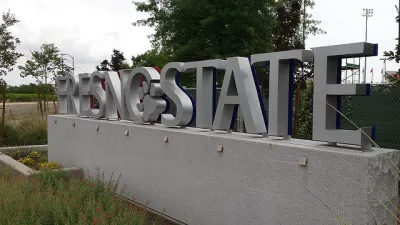Even as the Golden State has a wetter fall, California's water leaders have launched a new tool to leverage information technology and available information to support decisions around local water reliability.

Last month, the White House Council on Environmental Quality partnered with the California State Water Resources Control Board and other agencies to launch the California Water Data Challenge. In an exclusive interview with The Planning Report, State Water Board Chair Felicia Marcus discussed the importance of leveraging publicly available data to support creative solutions to California’s water challenges, as outlined in Governor Jerry Brown administration’s California Water Action Plan.
Marcus, who previously served as the administrator of the U.S. Environmental Protection Agency Region IX, described the opportunity of the Data Challenge as a way government has "basically thrown open the doors for the data world to look at all of the Water Action Plan and come up with their best ideas." As the recent historic drought has focused people's attention on utilizing data and technology to advance sensors and groundwater management, the State Water Board has looked for ways to incorporate basic water data from a rudimentary level. As Marcus explains, "Only in the last couple of years have we gotten the authority to ask for basic data on water use in more real time. In just the last two years, we’ve developed more data that we’ve ever had."
The challenge ahead is creating a culture of efficiency, Marcus believes, where the state can figure out a reasonable amount for each person indoors and for a landscape of whatever size that’s appropriate for your climate. Next steps for the State Water Board include updating Governor Brown's 2009 statute that aims for a 20% reduction in water use by 2020, as California will need to rapidly increase efficiency and water reuse as climate change impacts decrease Northern California snowfall. In thinking about the future, Marcus opines:
"We’re thinking about the next generation of that—not just a percentage off a given baseline calculated any number of ways, but a more fair and transparent way of finding a reasonable amount of water for Californians to aim for over a reasonable time period to become more resilient, to be more equitable because people are moving toward a similar target.
That’s where fairness comes in. People need some kind of guide or metric as to what’s reasonable and fair to aim for, so they don’t have to worry that they’re being held to a different standard than others. Data and transparency helps us to do more than assert that something is fair, but to lay it out so that everybody can see where other people are and that they’re moving toward it. I think it creates something of a social contract—a sense that we’re all in this together—around using our energy and water more wisely in an increasingly climate-disrupted world."
Check out Chair Felicia Marcus' assessment of the state's work to also increase the use of recycled water in The Planning Report.
FULL STORY: The Role of Water Data in California’s Conservation Efforts

Alabama: Trump Terminates Settlements for Black Communities Harmed By Raw Sewage
Trump deemed the landmark civil rights agreement “illegal DEI and environmental justice policy.”

Study: Maui’s Plan to Convert Vacation Rentals to Long-Term Housing Could Cause Nearly $1 Billion Economic Loss
The plan would reduce visitor accommodation by 25% resulting in 1,900 jobs lost.

Why Should We Subsidize Public Transportation?
Many public transit agencies face financial stress due to rising costs, declining fare revenue, and declining subsidies. Transit advocates must provide a strong business case for increasing public transit funding.

Paris Bike Boom Leads to Steep Drop in Air Pollution
The French city’s air quality has improved dramatically in the past 20 years, coinciding with a growth in cycling.

Why Housing Costs More to Build in California Than in Texas
Hard costs like labor and materials combined with ‘soft’ costs such as permitting make building in the San Francisco Bay Area almost three times as costly as in Texas cities.

San Diego County Sees a Rise in Urban Coyotes
San Diego County experiences a rise in urban coyotes, as sightings become prevalent throughout its urban neighbourhoods and surrounding areas.
Urban Design for Planners 1: Software Tools
This six-course series explores essential urban design concepts using open source software and equips planners with the tools they need to participate fully in the urban design process.
Planning for Universal Design
Learn the tools for implementing Universal Design in planning regulations.
Smith Gee Studio
Alamo Area Metropolitan Planning Organization
City of Santa Clarita
Institute for Housing and Urban Development Studies (IHS)
City of Grandview
Harvard GSD Executive Education
Toledo-Lucas County Plan Commissions
Salt Lake City
NYU Wagner Graduate School of Public Service



























